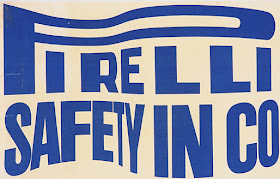Eckmann Schmuck Typeface designed by Otto Eckmann c 1900
http://doublemesh.com/tutorials/30-fantastic-photoshop-text-effect-tutorials/
Look at this number 7. Seven is a number - a bit of information. However, this little seven is soft and curly. It has an organic quality - it's swaying. I don't just think of the number seven. I think of Art Nouveau, Natural forms, maybe I am in Vienna, Old Europe, another world, another time - maybe the start of the 20th century. Blimey - it's only a number 7.
Letters have personality. They can be soft, strong, harsh, friendly, quiet or loud. Words are often given expression before we have read the word.
Edward Johnson - Underground Sign 1915
Where are we now? London, there's a war on and the 20th century has definitely started. Edward Johnson's iconic London Underground roundel and font are based on Classical Roman Proportions (with the letter 'O' being a perfect circle) yet seem a lot more 'modern' than Eckmann's. This simple sans serif font is easy to recognize and read. When you are in a rush, or speeding past a sign, you need the font to be simple. It was so successful it is still used today.
'Underground' is still used by designers to suggest London in the 20th century. Its simple, yet classic, quality suggest austerity and a certain period in British history. Mid twentieth century photographs are combined with the font on this album cover of Highlife and Jazz compilation to give a sense of an era and place.
Herbert Bayer - 'Universal' 1925
It is 1925 in Germany and the first world war is over. At the Bauhaus Herbert Bayer designs the 'Universal' font and this is an example of pure modernism.
In Otto Eckmann's 'Eckmann Schmuck' Typeface (shown at the start) we can see the difference between a Serif Face and a Sans Serif Face.
A serif face is flambouyant and has terminal strokes - a little flick. They seem closer to handwriting and therefore more old fashioned.
A sans serif typeface does not have terminal strokes - it is no nonsense, simple bold and modern. Herbert Bayer and the Bauhaus designers felt the flicks of Serifs were looking backwards - Bayer's 'Universal' font was looking towards the future. It was Modern.
Herbert Bayer 'Design for Cinema' 1924-1925
Joost Scmidt - Bauhaus Journal 'Offset' 1926
Bayer's simple, geometric typeface did not use capital letters. It was used in the Bauhaus publication 'Offset'. In this example above we can see the bold modern look - a combination of design and typography.
'Contruction de la lettre G' from the Imprimerie Royale, Paris 1716
The shapes had been designed around circles and parallel lines and set against a background grid. The use of geometric has been used to design many typefaces.
Eric Gill's 'Gill Sans' used geometry - and it is especially evident in the lower case 'g'. Circles and arches combine to make a beautifully simple font. The font has a modernist look and is similar to Paul Renner's - 'Futura' (read article here). However, it is slightly more fluid - making it easier to read.
Penguin book covers using Gill's 'Gill Sans'
Eric Gill was a sculptor, type designer and letter cutter who trained under Edward Johnston (see above) and also created the type face 'Pepetua'. You can sketch out your own fonts and turn them into usable fonts with Font Capture here.
Neville Brody - Typeface Six 1986
This is an example of Typeface Six designed by Neville Brody (see The typefaces of Neville Brody here). Neville Brody came to prominence as the art editor of the British music and style magazine 'The Face' during the 1980's.
Brody created layouts that combined photography, art and typography to create a look that would define the 1980's. As well as being of its time Brody's style was influenced by modernist design (particularly early 20th century Russian artist's like Alexanda Rodchenko).
Brody was one of the key designers who took advantage of technological advances to break away and reinvent traditional print setting. Brody often used a computer to design his various typefaces - the letter forms themselves used as a dramatic part of the composition. It is the 1980's and Brody's freedom to mix images and text hints at an approach that will be used by website designers a decade later.






























































